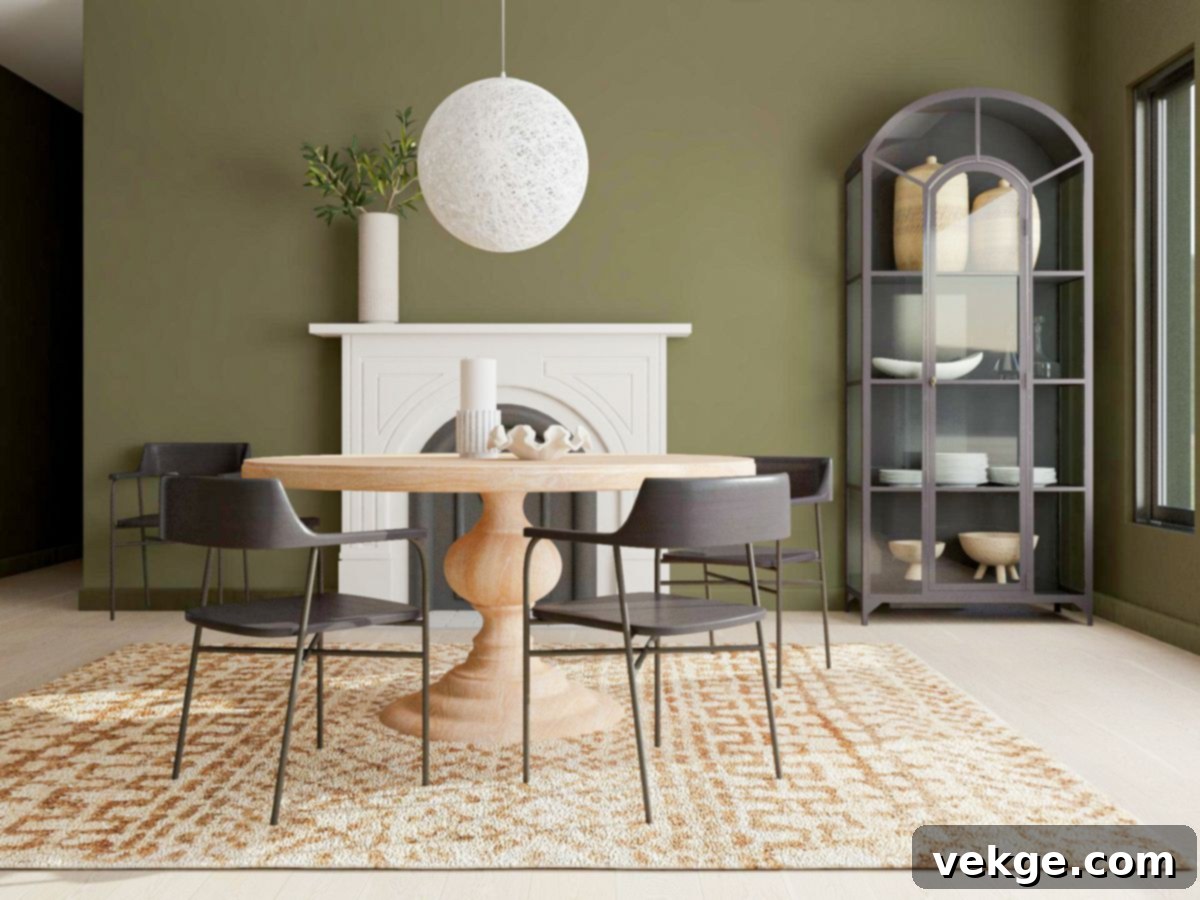Infuse Your Organic Modern Living Room with Nature-Inspired Colors: A Comprehensive Guide
Imagine stepping into a living room where tranquility reigns, and vibrant bursts of color, subtly inspired by the natural world, greet your eyes. In the realm of organic modern design, the line between your indoor sanctuary and the great outdoors gracefully blurs. This guide is your ultimate companion to injecting life, personality, and an undeniable sense of calm into your living space through thoughtful color choices. Whether your heart yearns for the gentle whisper of soft hues or the sophisticated statement of monochromatic palettes, the colors you select possess the profound ability to evoke profound serenity and timeless elegance.
Picture a room transformed by the delicate touch of soft greys harmonizing with subtle mustard yellows, elevating the space from merely functional to truly extraordinary. Throughout this journey, we will explore a spectrum of color strategies and styling insights, where each hue is not just a shade but a brushstroke in the masterpiece that is your home. Our aim is to help you create an environment that feels both sophisticated and inherently connected to nature, a true reflection of the organic modern ethos.
Are you ready to discover the perfect palette? Grab your color wheel now and prepare to paint your personal sanctuary with confidence and style!
Choosing Color Schemes for An Organic Modern Living Room
In the art of crafting an organic modern living room, color is far more than mere decoration; it is a fundamental element that shapes the entire experience of the space. The right choice of colors is paramount in cultivating a sense of coziness, refined style, and a deep connection to nature. Colors profoundly influence the room’s ambiance, mood, and overall aesthetic, ensuring a seamless blend between contemporary design and the raw beauty of the natural world. Neutral color palettes, often inspired by earthy elements like stone, wood, and natural fibers, serve as the foundational bedrock for the room’s visual identity, creating a serene and expansive backdrop perfectly aligned with the organic theme.
Beyond aesthetics, the colors surrounding us have a significant impact on our emotional well-being. Thoughtfully selected hues can foster a sense of calmness, balance, and mindfulness, transforming your living room into a true haven from the outside world. This design philosophy embraces natural light, sustainable materials, and a sense of uncluttered harmony, all of which are amplified and underscored by the intelligent application of color.
1. Neutral-Color Palette with a Pop of Colors
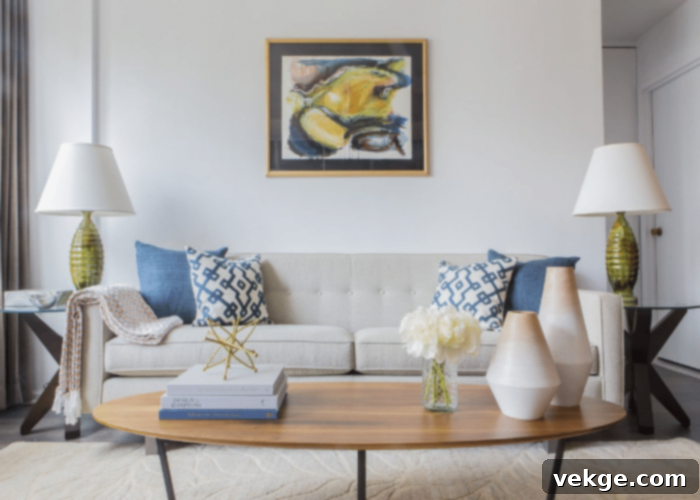
A neutral color palette, encompassing a sophisticated range of whites, beiges, creams, and soft grays, establishes a serene and timeless foundation for any organic modern living room. These foundational colors inherently create a sense of openness, airiness, and expansiveness, allowing the natural textures of wood, stone, linen, and wool to truly shine. They act as a quiet canvas, enhancing the raw beauty of organic elements and minimalist forms without competition.
To prevent the space from feeling too subdued or sterile, strategically inject a “pop of color” through carefully chosen accessories. Think vibrant throw pillows, captivating artwork, sculptural ceramic vases, or a lush botanical arrangement. These small but impactful accents breathe life and visual interest into the room, enlivening the atmosphere without overwhelming the inherent harmony between nature-inspired aesthetics and contemporary designs. Opt for muted jewel tones like a deep moss green, a soft terracotta, or a dusty blue to maintain the organic feel while adding depth and personality. The key is balance: let the neutrals define the calm, and the pops of color provide delightful surprises.
2. Monochromes
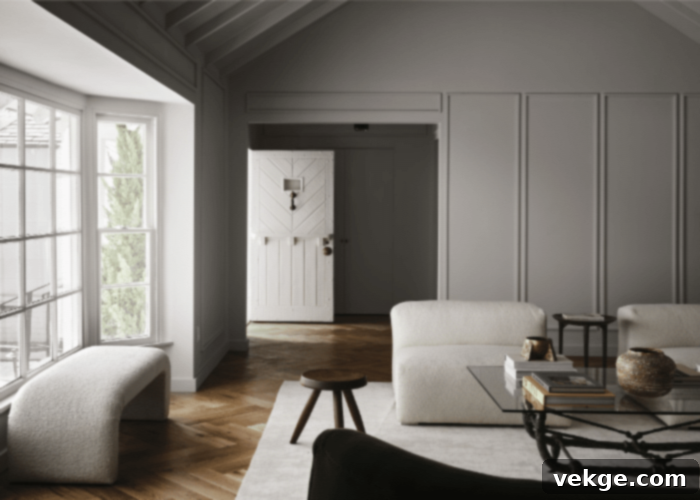
Monochromatic design is a sophisticated approach that involves using various shades, tints, and tones of a single base color. Far from being boring, this technique creates an incredibly cohesive, harmonious, and deeply restful aesthetic. By selecting a core color – perhaps a soft sage green, a warm oatmeal, or a deep charcoal gray – and exploring its lighter and darker variations, you can build a richly layered space that feels both understated and profoundly elegant.
Monochromatic schemes exude simplicity and refinement, fostering visual unity that makes the entire living area feel more organized, spacious, and meticulously curated. The subtle shifts in hue allow different textures and materials to come to the forefront, creating depth without requiring contrasting colors. Imagine a living room with varying shades of muted blue, from a pale sky blue on the walls to a deeper denim on upholstery, complemented by blue-grey ceramics and natural wood furniture. This subtle nature of monochromatic colors cultivates a profoundly calming atmosphere, simultaneously highlighting the intricate beauty of natural elements and craftsmanship. It’s a testament to the power of nuance in design.
3. Earth Tones
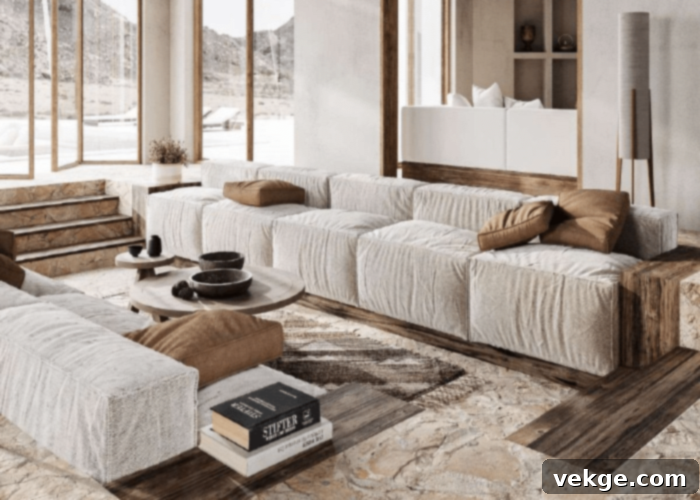
Earth tones are colors drawn directly from the organic world around us – think the rich hues of wood, the varied textures of stones, the deep greens of foliage, the raw beauty of clay, and the subtle variations of minerals. This inherently grounding color palette includes a comforting spectrum of browns, greens, beiges, creams, terracotta, muted reds, and soft oranges. These colors often form the dominant narrative in an organic modern living room, working in concert to create an atmosphere that is both profoundly serene and incredibly inviting.
Associated deeply with calmness, stability, and comfort, earth tones are essential for an interior that seeks to connect with nature. By thoughtfully incorporating these shades through natural wood furniture, linen upholstery, jute rugs, clay pottery, and living plants, you can effectively capture the timeless essence of nature within a sophisticated, modern context. Earth tones provide a sense of rootedness and warmth, making any space feel more substantial and nurturing. They are the cornerstone of the organic modern aesthetic, allowing natural light and diverse textures to play a starring role.
4. Pastels
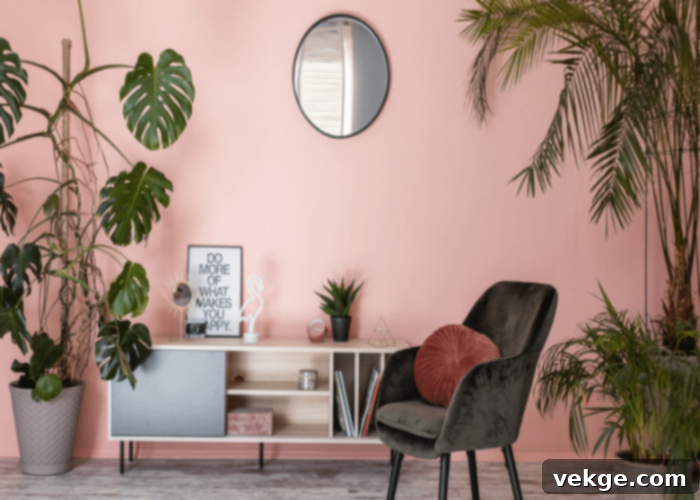
Pastel colors offer a truly delightful and refreshing addition to an organic modern living room, effortlessly infusing the space with a sense of softness, lightness, and contemporary charm. Shades like muted pink, sky blue, gentle lavender, and serene mint greens delicately mimic the subtle hues found in nature – think blooming flowers, soft morning skies, or tranquil waters. These delicate tones evoke a profound sense of calmness, sophistication, and understated elegance, perfectly aligning with the serene ethos of organic modern design.
Beyond their aesthetic appeal, pastels contribute significantly to overall psychological well-being, promoting a stress-free and wonderfully inviting environment. Their inherent lightness helps to expand the visual perception of space, creating an illusion of openness and airiness that prevents the room from feeling cluttered or heavy. When paired with natural materials like unfinished wood, textured linen, and organic cotton, pastels achieve a sophisticated balance, adding color without sacrificing the essential connection to nature. They are perfect for introducing a gentle touch of personality while maintaining a bright and expansive feel.
5. Bold Colors
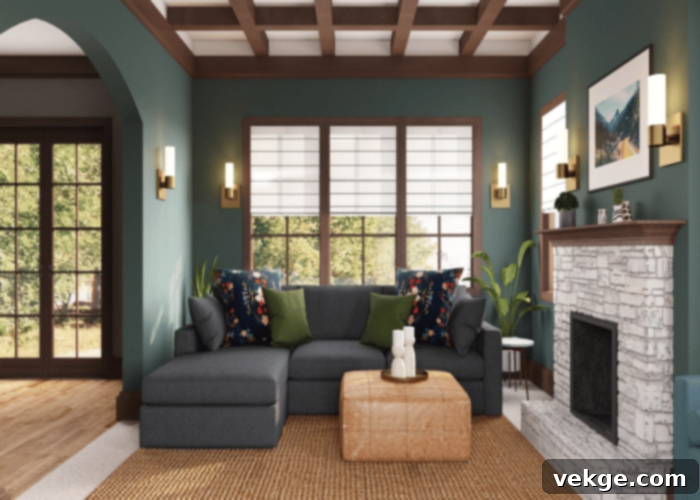
While organic modern living rooms often lean towards soothing neutrals and subdued tones, the strategic introduction of bold colors can profoundly infuse energy, vitality, and distinct character into the space. Rather than overpowering the natural elements, bold colors, when used thoughtfully, act as powerful focal points, adding depth, dynamic contrast, and a touch of individuality. The risk of too much neutrality is monotony; bold colors expertly prevent this, ensuring the room feels vibrant and expressive.
Consider a single accent wall painted in a deep emerald green, a rich sapphire blue sofa, or a statement piece of art boasting vibrant hues. These carefully placed bold elements inject personality and character, complementing rather than competing with the natural textures and organic forms prevalent in the design. Colors like deep terracotta, rich ochre, or a sophisticated charcoal can provide visual anchors, drawing the eye and grounding the space while still maintaining a connection to earthy origins. The key is moderation and strategic placement to achieve impact without overwhelming the inherent calm.
6. Cool and Calming Blues
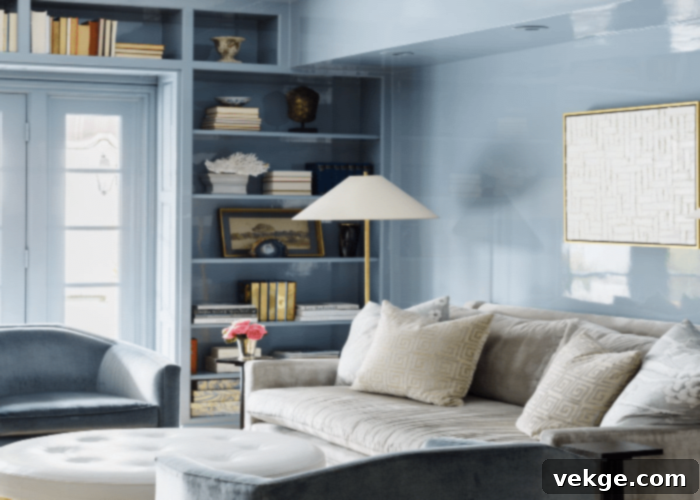
Blues are inherently intertwined with the natural world, representing vast skies and tranquil waters. In an organic modern living room, these cool and calming hues seamlessly blend with both the organic and modern aspects of the space, culminating in a harmonious, inviting, and utterly serene atmosphere. Blue shades, from a muted denim to a deep, earthy navy, possess an innate ability to evoke a profound sense of calmness and tranquility, effectively bringing the restorative power of the outdoors into your indoor living environment. This fosters a more holistic and peaceful living experience.
Lighter shades of blue, such as a delicate sky blue or a soft aqua, are particularly adept at enhancing the perception of space, creating an illusion of openness and airiness that complements minimalist design principles. Blues are widely recognized for their stress-reducing qualities and their capacity to promote mindfulness and relaxation. Incorporate blues through a statement rug, a comfortable upholstered armchair, or delicate glass accents. When balanced with warm natural wood tones or creamy neutrals, blue hues can create a wonderfully balanced and utterly timeless aesthetic that feels both fresh and comforting.
7. Accent Colors
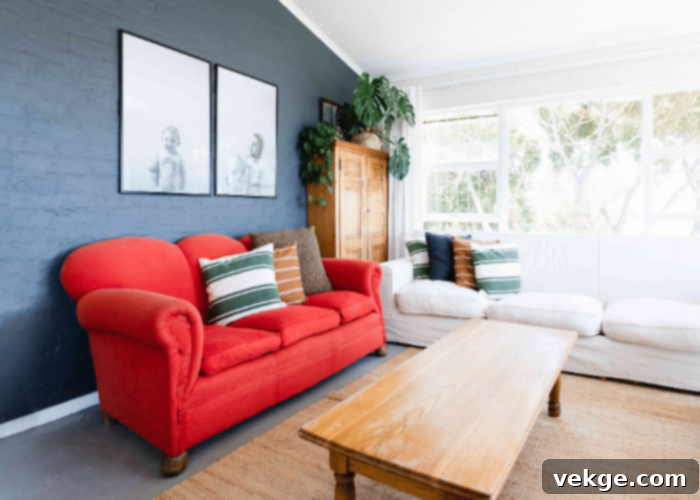
Accent colors are truly pivotal in transforming an organic modern living room from simply pleasant to captivatingly vibrant and perfectly balanced. These carefully chosen hues, such as warm burnt orange, deep olive green, sophisticated deep teal, cheerful mustard yellow, subtle rose gold, dusty pink, or soft lavender, should be strategically distributed throughout the room. The goal is to create visual interest and movement, often following the “rule of three” to ensure a cohesive and balanced look without overwhelming the serene primary palette.
Using too many accent colors or placing them haphazardly can disrupt the tranquil harmony of the space. Instead, strategically place them to highlight specific design elements, draw the eye to unique features, and inject personality. Vibrant, yet tastefully muted, accent colors like mustard yellow in a ceramic vase, a deep teal throw draped over a sofa, or navy blue cushions against a neutral backdrop, can instantly create a welcoming ambiance and add a delightful pop of brightness. They serve as punctuation marks in your design narrative, adding character and warmth while reinforcing the natural, understated elegance of the organic modern style.
8. Complementary Colors

For those seeking a more dynamic yet balanced aesthetic, integrating complementary colors can create visual interest and a captivating contrast that elevates the entire space. Complementary colors are those situated directly opposite each other on the color wheel – classic pairs include blue and orange, red and green, and yellow and purple. When placed together, they intensify each other, creating depth and a natural, lively contrast that can feel both stimulating and perfectly balanced.
In an organic modern context, the key is to use one complementary color as the dominant hue and introduce its counterpart as a well-measured accent. For example, a living room with a strong foundation of muted blues (like a dusty denim or a soft teal) could feature subtle accents of terracotta or burnt orange in throw pillows, a small ceramic pot, or an abstract art piece. This combination generates a striking equilibrium and a harmonious dialogue between the organic elements and contemporary design. Using such complementary-colored accessories – think accent pillows, unique artwork, or decorative pieces – adds a sophisticated layer of color and intrigue without ever overpowering the room’s overarching natural and minimalist theme. It’s a bold step that still respects the quiet elegance of organic modernism.
Conclusion: Crafting Your Harmonious Organic Modern Retreat
Just as nature orchestrates a breathtaking blend of diverse elements into a harmonious whole, your chosen colors will collaboratively create a living space that feels limitless, inviting, and deeply personal. From the soothing whispers of cool blues to the vibrant declarations of accent colors, from the grounding presence of earth tones to the soft charm of pastels, each shade plays a vital role in capturing the essence of your lifestyle and vision. These thoughtful color selections are the threads that weave together the tapestry of your organic modern home, making it a true reflection of both the serene beauty of the natural world and the crisp lines of contemporary design.
We sincerely hope this comprehensive guide has empowered you with the inspiration and knowledge to curate an organic modern living room that is not just aesthetically pleasing, but a genuine testament to your personal style and desire for a peaceful, balanced environment. The foundation of neutral hues, the calming embrace of cool blues, and the gentle touch of pastels collectively contribute to a profound sense of serenity. Meanwhile, the strategic inclusion of accent and complementary colors adds layers of creativity, vibrancy, and unique character, ensuring your space is far from mundane.
Ultimately, the most important criterion is that you genuinely love the colors you choose. They should resonate with you, uplift your spirits, and authentically reflect your individual style and comfort. Do not shy away from experimentation, and trust your instincts. Go ahead and paint your style – your harmonious, organic modern living room awaits!
